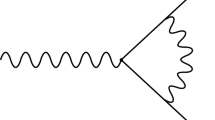Summary
We propose a form for a dual resonant amplitude in which both duality and factorization are explicitly exhibited. This result is achieved by considering in detail the transformation properties of the operators appearing in the model under the fundamental projective transformation of Koba and Nielsen.
Riassunto
Si propone una forma per l'ampiezza duale risonante in cui, sia la dualità, sia la fattorizzazione sono esplicitamente esibite. Questo risultato è ottenuto studiando in dettaglio le proprietà degli operatori rispetto alla trasformazione proiettiva di Koba e Nielsen.
Резюме
Мы предлагаем форму для дуальной резонансной амплитуды, в которой явно проявляются и дуализм и факторизация. Этот результат достигается путем подробного рассмотрения свойств преобразований операторов, которые возникают в этой модели при основном проективном преобразовании Коба и Нильсена.
Similar content being viewed by others
References
S. Fubini, D. Gordon andG. Veneziano:Phys. Lett.,29 B, 679 (1969), hereafter referred to as I;Y. Nambu: Enrico Fermi Institute preprint COO264-507 (1969).
For a review of the subject see II.M. Chan:The generalized Veneziano model, CERN preprint No. TH-1057 (1969).
S. Fubini andG. Veneziano:Nuovo Cimento,64 A, 811 (1969) (hereafter referred to as II), MIT preprint No. 81 (1969);K. Bardakçi andS. Mandelstam:Phys. Rev.,184, 1640 (1969).
D. Amati, C. Bouchiat andJ. L. Gervais:Lett. Nuovo Cimento,2, 399 (1969).
S. Sciuto:Lett. Nuovo Cimento. 2, 411 (1969), see also ref. (6)L. Caneschi, A. Schwimmer andG. Veneziano:Phys. Lett.,30 B, 351 (1969).
L. Caneschi, A. Schwimmer andG. Veneziano:Phys. Lett.,30 B, 351 (1969);L. Caneschi andA. Schwimmer: SLAC preprint (1969).
F. Gliozzi:Lett. Nuovo Cimento,2, 846 (1969);C. B. Chiu, S. Matsuda andC. Rebbi:Phys. Rev. Lett.,23, 1526 (1969);C. B. Thorn: Berkeley preprint (1969);D. Amati, M. LeBellac andD. Olive:Nuoro Cimento,66 A, 815 (1969). The potentially important result that more Ward identities appear for special values of the trajectory intercept has been found byM. A. Virasoro: University of Wisconsin preprint No. 600-267 (1969).
Z. Koba andH. B. Nielsen:Nucl. Phys., B10, 633 (1969).
E. Donini andS. Sciuto: University of Torino preprint (1969) (to be published inAnn. of Phys.).
Equations (2.12), (2.13) and (2.14) have been independently obtained byC. B. Chiu, S. Matsuda andC. Rebbi: Cal Tech preprint (1969).
The correspondence between theb operators here and thea operators ofI is\({{b_n^{( + )} \to a^{(n)} } \mathord{\left/ {\vphantom {{b_n^{( + )} \to a^{(n)} } {\sqrt n }}} \right. \kern-\nulldelimiterspace} {\sqrt n }},{{b_n^{( - )} \to a^{ + (n)} } \mathord{\left/ {\vphantom {{b_n^{( - )} \to a^{ + (n)} } {\sqrt n }}} \right. \kern-\nulldelimiterspace} {\sqrt n }}\). There is also of course a four-vector index μ implicitly understood ina andb.
Because of the discussion of Sect.3 one must be careful for the zero frequency operatorsp 20 . To be rigorous one should keep up to the end the operatorsx p 20 acting on <0‖ and eliminate them only after establishing eq. (4.13).
These appropriate combinations can be almost guessed by looking at the master equation given byY. Nambu in ref. (1) Enrico Fermi Institute preprint COO264-507 (1969). with the interaction term included.
At this point it is amusing to speculate a little on the meaning of the projective variablez (ϱ in this Section). If we define a variable τ byz=exp⌊−iτ⌋ the natural internation of τ is that of some time variable. Indeed the η function of equation (A.6) of the Appendix becomes η(τy−ηr), and so do the θ functions in the volume element. This is not unnatural if τ is a time. Furthermore the commutator withL 3, which is related to the energy, gives a dilation inz. i.e. a shift in τ. Finally we can rewriteQ(z) asQ(z)=q 0+ip0logz=q 0+p0τ, which again resembles the position of a particle of momentump at the time τ. The identification of τ with a proper time variable was indeed put forward byY. Miyamoto (Tokyo University preprint (1969)). A variable ξ=ilogz was also considered byY. Nambu in ref. (1) Enrico Fermi Institute preprint COO264-507 (1969).
We should note however that it is not possible to treat the nonzero mass case without somewhat altering the formalism. The ground state ‖0>, for instance, no longer corresponds to a physical one-particle state as it is in the zero-mass case. It may very well be that one needs nontrivial modifications of the formalism of Sect.3 in order to treat the case of nonzero masses in a fully consistent group-theoretical way.
Author information
Authors and Affiliations
Additional information
This work has been supported in part by U.S. Atomie Energy Commission under Contract AT(30-1) 2098.
Переведено редакцией.
Rights and permissions
About this article
Cite this article
Fubini, S., Veneziano, G. Duality in operator formalism. Nuovo Cimento A (1965-1970) 67, 29–47 (1970). https://doi.org/10.1007/BF02728411
Received:
Published:
Issue Date:
DOI: https://doi.org/10.1007/BF02728411



